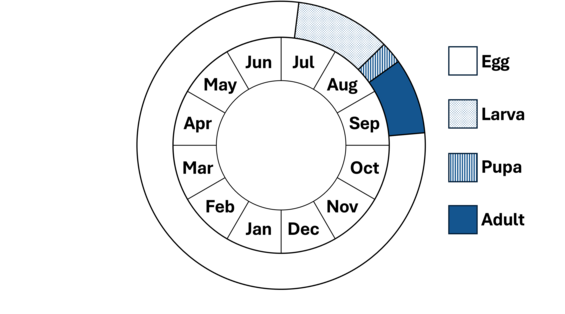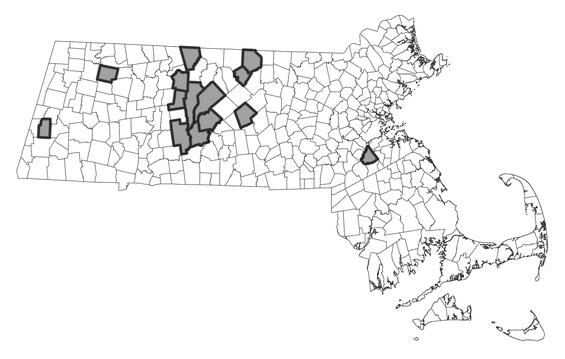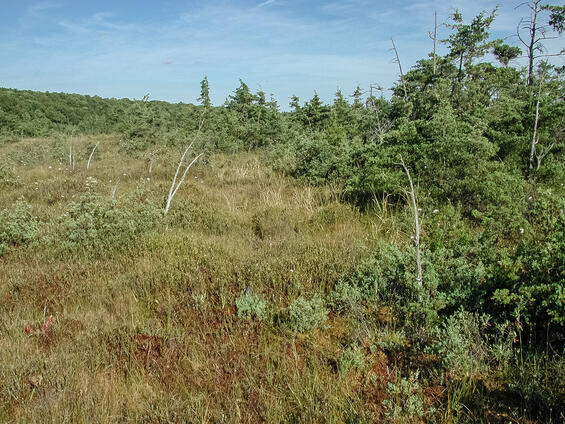- Scientific name: Papaipema appassionata
- Species of Greatest Conservation Need (MA State Wildlife Action Plan)
- Threatened (MA Endangered Species Act)
Description

Pitcher plant borer, Papaipema appassionata
The pitcher plant borer (Papaipema appassionata) is a noctuid moth with a wingspan of 30-41 mm (1.2-1.6 in) (Covell 1984). The median and basal areas of the forewing are yellow in color, with maroon shading between the reniform and orbicular spots and solid maroon distal to the postmedial line and proximal to the antemedial line. The postmedial, antemedial, and basal lines are double and maroon in color; the median line is single, also maroon. The reniform spot is a large, elongate white ring, extending to the inner postmedial line and filled with yellow. The orbicular and claviform spots are white, typically large and fused, occasionally smaller and separate. The hind wing is pale, yellowish-tan, with pale red shading distally. The elongate scales of the head and thorax are predominantly maroon in color, mixed with a variable amount of yellow; the abdomen is pale, yellowish-tan tinged with pale red.
Life cycle and behavior
In Massachusetts, pitcher plant borer moths fly in late August and September. Eggs overwinter, hatching in early summer. Larvae bore into and feed internally on the roots of pitcher plants (Sarracenia purpurea), also consuming leaves in later instars. Larvae pupate by August.

Distribution and abundance
The pitcher plant borer is found from New Brunswick south to Rhode Island and west to Minnesota and Wisconsin. A small number of rare and localized populations occur on the coastal plain south to the Carolinas (Wagner et al. 2011). In Massachusetts, populations of this species are concentrated in northern Worcester and eastern Franklin and Hampshire Counties, with more isolated populations in Berkshire, Norfolk, and Plymouth Counties.

Distribution in Massachusetts.
1999-2024
Based on records in the Natural Heritage Database.
Habitat
In Massachusetts, the pitcher plant borer inhabits acidic Sphagnum bogs with pitcher plants (Sarracenia purpurea).
Healthy habitats are vital for supporting native wildlife and plants. Explore habitats and learn about conservation and restoration in Massachusetts.

Acidic Sphagnum bog with pitcher plants, habitat for the pitcher plant borer. Habitat managed by DCR at Blue Hills Reservation.
Threats
The pitcher plant borer is threatened by habitat loss and alteration of the natural hydrology of its habitat. Other potential threats include invasion by exotic plants, eutrophication or other water pollution, aerial insecticide spraying, non-target herbicide application, and off-road vehicles. With the exception of a few rare, peripherally isolated populations on the coastal plain, the pitcher plant borer is a northern species with a relatively narrow latitudinal range. Therefore, it is vulnerable to a warming climate. Northward range expansion may be possible, though this has not yet been documented.
Conservation
Land protection and habitat management are the primary conservation needs of the pitcher plant borer in Massachusetts. In particular, acidic Sphagnum bogs with pitcher plants should be conserved, restored, and managed to maintain habitat for this species and other species dependent on such habitat.
Survey and monitoring
The distribution of the pitcher plant borer in Massachusetts is relatively well documented. Known populations of this species should be surveyed to document persistence at least once every 25 years; every 10 years is more desirable when practicable.
Management
Management of acidic Sphagnum bogs with pitcher plants should include restoring and/or maintaining natural hydrology and control of invasive exotic plants. Habitat condition should be monitored and management adapted as needed.
Research needs
The natural history and conservation needs of the pitcher plant borer are relatively well known. However, the future effects of a warming climate on this species are unpredictable and should be documented.
References
Covell, C.V. 1984. A Field Guide to Moths of Eastern North America. Peterson Field Guide Series. Houghton Mifflin, Boston, Massachusetts. 496 pp.
Wagner, D.L., D.F. Schweitzer, J.B. Sullivan, and R.C. Reardon. 2011. Owlet Caterpillars of Eastern North America. Princeton University Press, Princeton, New Jersey. 576 pp.
Contact
| Date published: | March 24, 2025 |
|---|